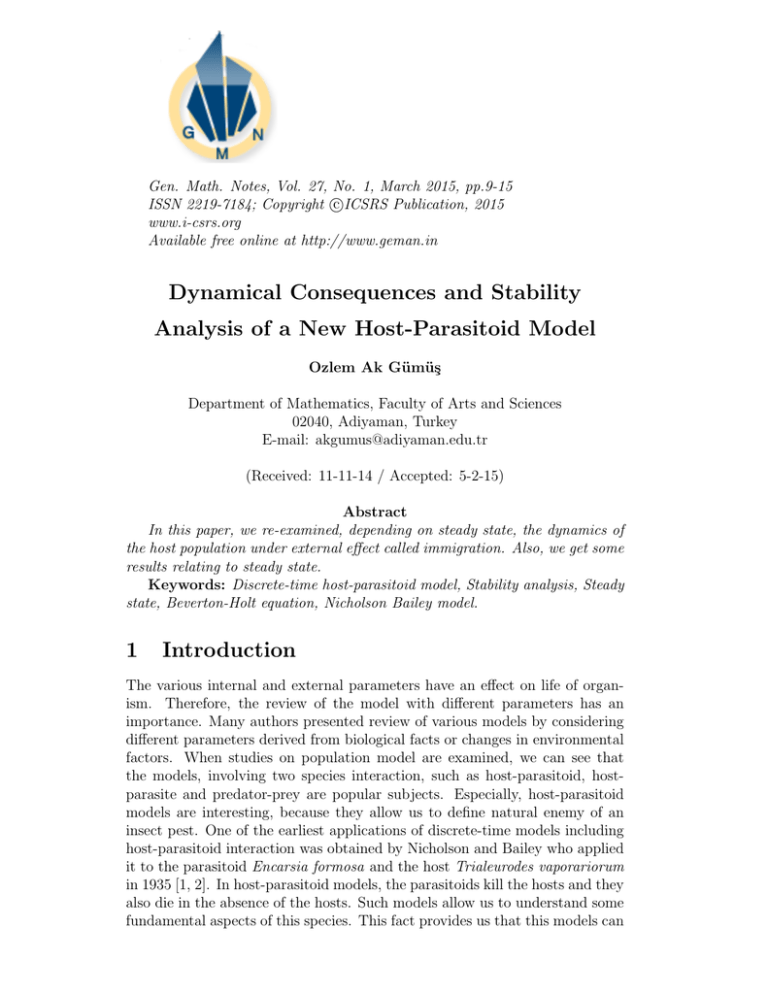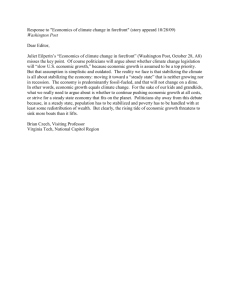Document 10815309
advertisement

Gen. Math. Notes, Vol. 27, No. 1, March 2015, pp.9-15 c ISSN 2219-7184; Copyright ICSRS Publication, 2015 www.i-csrs.org Available free online at http://www.geman.in Dynamical Consequences and Stability Analysis of a New Host-Parasitoid Model Ozlem Ak Gümüş Department of Mathematics, Faculty of Arts and Sciences 02040, Adiyaman, Turkey E-mail: akgumus@adiyaman.edu.tr (Received: 11-11-14 / Accepted: 5-2-15) Abstract In this paper, we re-examined, depending on steady state, the dynamics of the host population under external effect called immigration. Also, we get some results relating to steady state. Keywords: Discrete-time host-parasitoid model, Stability analysis, Steady state, Beverton-Holt equation, Nicholson Bailey model. 1 Introduction The various internal and external parameters have an effect on life of organism. Therefore, the review of the model with different parameters has an importance. Many authors presented review of various models by considering different parameters derived from biological facts or changes in environmental factors. When studies on population model are examined, we can see that the models, involving two species interaction, such as host-parasitoid, hostparasite and predator-prey are popular subjects. Especially, host-parasitoid models are interesting, because they allow us to define natural enemy of an insect pest. One of the earliest applications of discrete-time models including host-parasitoid interaction was obtained by Nicholson and Bailey who applied it to the parasitoid Encarsia formosa and the host Trialeurodes vaporariorum in 1935 [1, 2]. In host-parasitoid models, the parasitoids kill the hosts and they also die in the absence of the hosts. Such models allow us to understand some fundamental aspects of this species. This fact provides us that this models can 10 Ozlem A.K. Gümüş be tested with some data. Therefore, parasitoids are used as biological control agents and preferred instead of chemicals which are non-nature control. The general host-parasitoid model proposed by Nicholson-Bailey is presented in the following form Ht+1 = rHt f (Ht , Pt ) Pt+1 = eHt (1 − f (Ht , Pt )) where, r and e are positive parameters [2]. Also, f (Ht , Pt ) is a fraction of hosts that are not parasitized; Nt is the density of host species in generation t; Pt is the density of parasitoid species in generation t; r is the number of eggs laid by a host that survive through the larvae, pupae and adult stages; e is the number of eggs laid by parasitoid on a single host that survive through larvae, pupae and adult stages. The number of encounters of the parasitoid with a host according to the law of mass action is defined as cNt Pt . Here, the constant c is the searching efficiency. Nicholson-Bailey model assumes that the number of encounters is calculated according to the Poisson distribution such that p(n) = e−σ σ n /n!, where n is the number of encounters and σ is the avarege number of encounters per host in one generation. If there is no encounter, the fraction of hosts that are not parasitized is p(0) = e−σ σ 0 /0! = e−σ , where σ =encounters/Nt = cPt . Then f (Ht , Pt ) = e−cPt . Accordingly, the model is given as Nt+1 = rNt e−cPt Pt+1 = eNt (1 − e−cPt ). In this paper, we review the dynamic of the host and parasitoid interaction connected to Beverton-Holt function given in [4] under immigration parameter (see, [3]) as follows: λNt e−bPt + β 1 + kNt e−bPt = αNt (1 − e−bPt ). Nt+1 = Pt+1 (1) Here, β ∈ (1, ∞) is a diffusive force which called as immigration; Nt is the host population at time t; Pt is the parasitoid population at time t and α presents the average number of offsprings of parasitized host. The growth rate of the host population in the absence of the parasitoid, 1+kNλt e−bPt , is associated with the Beverton-Holt function such that λ, k > 0. The aim of this study is to find steady states of the model (1) analytically and also to investigate the local stability of steady states. 11 Dynamical Consequences and Stability... 2 Steady States of the Model (1) In this section, we will obtain the steady states of model (1) by using Nt = Nt+1 = N ∗ and Pt = Pt+1 = P ∗ as follows: N ∗ P∗ λN ∗ −bP ∗ = +β ∗e ∗ −bP 1 + kN e ∗ = αN ∗ (1 − e−bP ). (2) It is clearly seen that there is no steady state (0, 0), since β ∈ (1, ∞). Then, we have the following the theorems. Theorem 2.1 Model (1) has steady state (N ∗ ,0). Proof: Let’s take N ∗ 6= 0 and P ∗ = 0. Then we can write λ= (1 + kN ∗ )(N ∗ − β) . N∗ (3) So, the following function can be created by using the right side of Eq.(3) such that N ∗ = x. (1 + kx)(x − β) f (x) = . (4) x In this way, if the derivation of the function f (x) is calculated, we have f 0 (x) = (kx2 + β) . x2 If f 0 (x) = 0 is solved, the function f (x) has no real root in the interval [β, ∞) on the first domain. So, we get that the function f has no critical point, that is, f 0 (x) > 0 in the interval [β, ∞) on the first domain ( limx→∞ f (x) = ∞.). Eq.(3) has only one solution. The proof is completed. Theorem 2.2 In case of β < (1) has steady state (N1∗ , P1∗ ). N1∗ < −(1−λ−βk)+ √ (1−λ−βk)2 +4βk , 2k the model Proof: If model (1) is taken into account for N1∗ 6= 0 and P1∗ 6= 0, we obtain ∗ ∗ ∗ N1∗ (1 + kN1∗ e−bP1 ) = λN1∗ e−bP1 + β(1 + kN1∗ e−bP1 ) ∗ ⇒ e−bP1 = N1∗ − β −kN1∗2 + (λ + βk)N1∗ 1 N1∗ − β ⇒ P1∗ = − ln . b −kN1∗2 + (λ + βk)N1∗ (5) (6) 12 Ozlem A.K. Gümüş If we have the following inequality 0< N1∗ − β < 1, −kN1∗2 + (λ + βk)N1∗ (7) then P1∗ > 0. If we combine Eq. (5) with the second equation of (2), then we get N1∗ − β ). P1∗ = αN1∗ (1 − −kN1∗2 + (λ + βk)N1∗ If P1∗ is written in the first equation in (2), we obtain N1∗ λN1∗ = −αbN1∗ (1− 1 + kN1∗ e −αbN1∗ (1− ∗ −β N1 ∗2 +(λ+βk)N ∗ ) −kN1 1 e N ∗ −β ⇒ N1∗ [1 + 1 −αbN1∗ (1− ∗2 +(λ+βk)N ∗ ) −kN1 1 ] kN1∗ e β[1 + kN1∗ e ∗ −β N1 −αbN1∗ (1− ∗2 +(λ+βk)N ∗ ) −kN1 1 ∗ −β N1 ∗2 +(λ+βk)N ∗ ) −kN1 1 ∗ = +β ∗ −β N1 −αbN1 (1− ∗2 +(λ+βk)N ∗ ) −kN1 1 λN1∗ e + ] ∗ N1 −β −αbN1∗ (1− β ∗2 +(λ+βk)N ∗ ) ∗ −kN1 1 + kN ]. ⇒ λ = (1 − ∗ )[e (8) 1 N1 Now, let’s take N1∗ = x. We can write the function by considering the right side of (8) as follows: g(x) = (1 − β x −αbx(1− )(e β−x ) kx2 −(λ+βk)x + kx). (9) If derivatives of the function g(x) are examined, there is no extremum. Note that g(β) = 0, g 0 (β) = β1 ebαβ > 0, and also g(x) → ∞ as x → ∞. Then (8) must have only one solution. Now, if we simplify inequality (7) by solving it, then we get p −(1 − λ − βk) + (1 − λ − βk)2 + 4βk λ + βk ∗ ∗ β < N1 < and N1 < . (10) k 2k √ −(1−λ−βk)+ (1−λ−βk)2 +4βk λ+βk Let’s compare k and . Assume that 2k p −(1 − λ − βk) + (1 − λ − βk)2 + 4βk λ + βk > (11) k 2k holds. If the process is continued, we obtain p 1 + λ + βk > (1 − λ − βk)2 + 4βk ⇔ (1 + λ + βk)2 > (1 − λ − βk)2 + 4βk ⇔ 4λ > 0. Dynamical Consequences and Stability... Since λ > 0, our assumption is true. Now, we need to show p −(1 − λ − βk) + (1 − λ − βk)2 + 4βk . β< 2k 13 (12) From this, we can that the following the result p βk + 1 − λ < (1 − λ − βk)2 + 4βk ⇔ (βk + 1 − λ)2 < (1 − λ − βk)2 + 4βk ⇔ 0 < 4βk. Similarly, we can see that our assumptions are true, since β > 0 and k > 0 . So, (12) is provided. Then, we have p −(1 − λ − βk) + (1 − λ − βk)2 + 4βk ∗ β < N1 < (13) 2k from (10), (11) and (12). The proof is completed. Corollary 2.3 When inequality (13) is not provided, (N ∗ , 0) is uniqe steady state of model (1). Otherwise, (N1∗ , P1∗ ) is only unique steady state. 2.1 Stability Analysis of Model (1) In this section, we will investigate the local stability conditions of steady state of (1). Firstly, we assume that inequality (13) is not provided. Namely, we have only unique steady state (N ∗ , 0). If the model (1) is considered, we can write λNt e−bPt + β 1 + kNt e−bPt G(Ht , Pt ) = αNt (1 − e−bPt ). F (Nt , Pt ) = If the Jacobian matrix of model (1) is created in the neighborhood of (N ∗ , 0), then we have λ −bλN ∗ ∗ 2 ∗ 2 J1 = (1+kN ) (1+kN ∗) . 0 αbN λ ∗ The eigenvalues of J1 are σ1 = (1+kN ∗ )2 and σ2 = αbN . Let’s apply the stability conditions |σ1 | < 1and |σ2 | < 1. So, (N ∗ , 0) is local stable if λ < 1 and αbN ∗ < 1 (1 + kN ∗ )2 (14) λ ∗ holds. Let’s take (1+kN > 1 under inequality (13). So, (N ∗ , 0) ∗ )2 > 1 and αbN is unstable. Then the stability of the model (1) which has only unique steady 14 Ozlem A.K. Gümüş state (N1∗ , P1∗ ) can be examined. The Jacobian matrix which is evaluated in the neighborhood of (N1∗ , P1∗ ) can be written as follows: " # ∗ ∗ bλN1∗ e−bP1 λe−bP1 − ∗ ∗ (1+kN1∗ e−bP1 )2 J2 = (1+kN1∗ e−bP1 ∗)2 . ∗ −bP1 α(1 − e ) αbN1∗ e−bP1 The trace and determinant of J2 are ∗ trJ2 det J2 λe−bP1 ∗ + αbN1∗ e−bP1 = ∗ −bP1∗ 2 (1 + kN1 e ) ∗ −bP1∗ αbλN1 e . = ∗ (1 + kN1∗ e−bP1 )2 respectively. If the following inequality (see [2]) is provided |trJ2 | < 1 + det J2 < 2, (15) then (N1∗ , P1∗ ) is local stable. By using (15), we get the local stability conditions for (N1∗ , P1∗ ) as ∗ ∗ αbλN1∗ e−bP1 (λ − αbλN1∗ )e−bP1 ∗ < 1 and + αbλN1∗ e−bP1 < 1. ∗ ∗ −bP1 2 ∗ −bP1∗ 2 ) ) (1 + kN1 e (1 + kN1 e (16) Corollary 2.4 If inequality (13) is not provided, then the model (1) has only unique steady state (N ∗ , 0), and it is stable under conditions (14). Corollary 2.5 If inequality (13) is provided, then the steady state (N1∗ , P1∗ ) is only unique steady state, and it is stable under conditions (16). 3 Conclusion In this paper, we investigated the steady state of the host-parasitoid model with immigration parameter. Also, we examined the local stability of steady state of this model. So, we have reached some consequences which give conditions on stability of the steady states. References [1] A. Nicholson and V. Bailey, The balance of animal population, Proc. Zool. Soc. Lond., 3(1935), 551-598. [2] L.J.S. Allen, An Introduction to Mathematical Biology, Pearson, New Jersey, (2007). Dynamical Consequences and Stability... 15 [3] M.R.S. Kulenovic and G. Ladas, Dynamics of Second Order Rational Difference Equations: With Open Problems and Conjectures, America, (2002). [4] R. Sophia, J. Jang and J.L. Yu, A discrete-time host parasitoid model, Proceedings of the Conference on Differantial and Difference Equations and Applications, Hindawi Publishing Corporation, (2006), 451-455.





